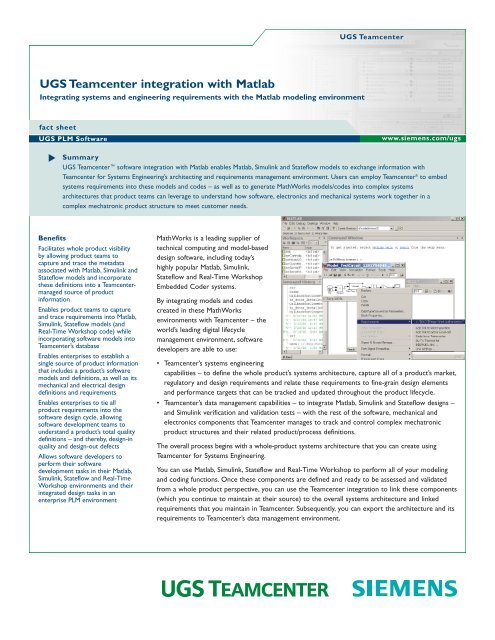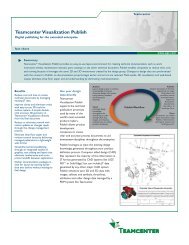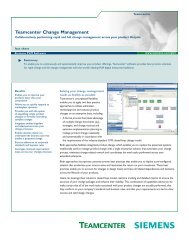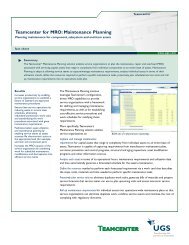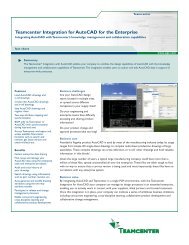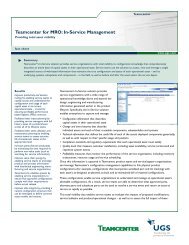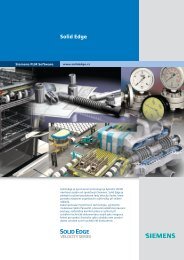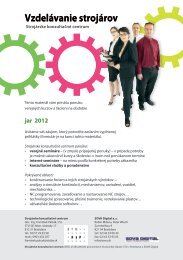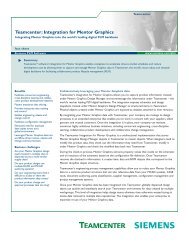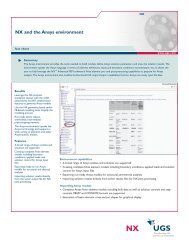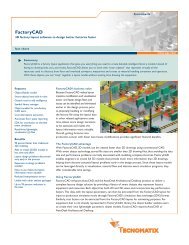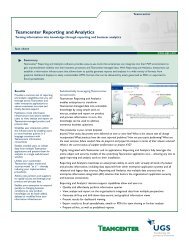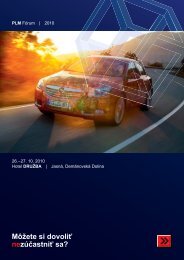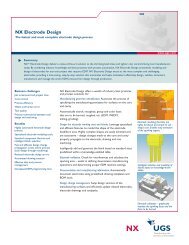Teamcenter -- Matlab Integration fact sheet - SOVA Digital
Teamcenter -- Matlab Integration fact sheet - SOVA Digital
Teamcenter -- Matlab Integration fact sheet - SOVA Digital
Create successful ePaper yourself
Turn your PDF publications into a flip-book with our unique Google optimized e-Paper software.
UGS <strong>Teamcenter</strong><br />
UGS <strong>Teamcenter</strong> integration with <strong>Matlab</strong><br />
Integrating systems and engineering requirements with the <strong>Matlab</strong> modeling environment<br />
<strong>fact</strong> <strong>sheet</strong><br />
UGS PLM Software<br />
www.siemens.com/ugs<br />
Summary<br />
UGS <strong>Teamcenter</strong> software integration with <strong>Matlab</strong> enables <strong>Matlab</strong>, Simulink and Stateflow models to exchange information with<br />
<strong>Teamcenter</strong> for Systems Engineering’s architecting and requirements management environment. Users can employ <strong>Teamcenter</strong> ® to embed<br />
systems requirements into these models and codes – as well as to generate MathWorks models/codes into complex systems<br />
architectures that product teams can leverage to understand how software, electronics and mechanical systems work together in a<br />
complex mechatronic product structure to meet customer needs.<br />
Benefits<br />
Facilitates whole product visibility<br />
by allowing product teams to<br />
capture and trace the metadata<br />
associated with <strong>Matlab</strong>, Simulink and<br />
Stateflow models and incorporate<br />
these definitions into a <strong>Teamcenter</strong>managed<br />
source of product<br />
information<br />
Enables product teams to capture<br />
and trace requirements into <strong>Matlab</strong>,<br />
Simulink, Stateflow models (and<br />
Real-Time Workshop code) while<br />
incorporating software models into<br />
<strong>Teamcenter</strong>’s database<br />
Enables enterprises to establish a<br />
single source of product information<br />
that includes a product’s software<br />
models and definitions, as well as its<br />
mechanical and electrical design<br />
definitions and requirements<br />
Enables enterprises to tie all<br />
product requirements into the<br />
software design cycle, allowing<br />
software development teams to<br />
understand a product’s total quality<br />
definitions – and thereby, design-in<br />
quality and design-out defects<br />
Allows software developers to<br />
perform their software<br />
development tasks in their <strong>Matlab</strong>,<br />
Simulink, Stateflow and Real-Time<br />
Workshop environments and their<br />
integrated design tasks in an<br />
enterprise PLM environment<br />
MathWorks is a leading supplier of<br />
technical computing and model-based<br />
design software, including today’s<br />
highly popular <strong>Matlab</strong>, Simulink,<br />
Stateflow and Real-Time Workshop<br />
Embedded Coder systems.<br />
By integrating models and codes<br />
created in these MathWorks<br />
environments with <strong>Teamcenter</strong> – the<br />
world’s leading digital lifecycle<br />
management environment, software<br />
developers are able to use:<br />
• <strong>Teamcenter</strong>’s systems engineering<br />
capabilities – to define the whole product’s systems architecture, capture all of a product’s market,<br />
regulatory and design requirements and relate these requirements to fine-grain design elements<br />
and performance targets that can be tracked and updated throughout the product lifecycle.<br />
• <strong>Teamcenter</strong>’s data management capabilities – to integrate <strong>Matlab</strong>, Simulink and Stateflow designs –<br />
and Simulink verification and validation tests – with the rest of the software, mechanical and<br />
electronics components that <strong>Teamcenter</strong> manages to track and control complex mechatronic<br />
product structures and their related product/process definitions.<br />
The overall process begins with a whole-product systems architecture that you can create using<br />
<strong>Teamcenter</strong> for Systems Engineering.<br />
You can use <strong>Matlab</strong>, Simulink, Stateflow and Real-Time Workshop to perform all of your modeling<br />
and coding functions. Once these components are defined and ready to be assessed and validated<br />
from a whole product perspective, you can use the <strong>Teamcenter</strong> integration to link these components<br />
(which you continue to maintain at their source) to the overall systems architecture and linked<br />
requirements that you maintain in <strong>Teamcenter</strong>. Subsequently, you can export the architecture and its<br />
requirements to <strong>Teamcenter</strong>’s data management environment.
<strong>fact</strong> <strong>sheet</strong><br />
UGS <strong>Teamcenter</strong><br />
Benefits continued<br />
Enables cross-discipline teams to<br />
participate in an integrated design<br />
environment that accounts for the<br />
entire product configuration as it<br />
evolves across all of its lifecycle<br />
states<br />
Allows enterprises to incorporate<br />
software development processes<br />
within their global product<br />
development cycle, including<br />
processes that require change<br />
management, software problem<br />
reporting and release level tracking<br />
Enables enterprises to accelerate<br />
their product lifecycle, improve its<br />
quality and reduce its cost by<br />
allowing product development<br />
teams to understand the impact of<br />
software design as early in the<br />
product lifecycle as possible<br />
Features<br />
Data integrity ensured by vaulting<br />
<strong>Matlab</strong>, Simulink, Stateflow and Real-<br />
Time Workshop metadata in<br />
<strong>Teamcenter</strong> while retaining bulk of<br />
theses models/codes at their source<br />
Automatic data exchange between<br />
the MathWorks applications and<br />
<strong>Teamcenter</strong> initiated by ad hoc user<br />
queries, as well as demand-driven<br />
and event-driven data requests<br />
Dynamic part support (ability to<br />
link <strong>Matlab</strong>, Simulink and Stateflow<br />
files to <strong>Teamcenter</strong> parts, thereby<br />
ensuring that every part query<br />
retrieves its related software<br />
component)<br />
Automatic synchronization between<br />
<strong>Matlab</strong>/Simulink/Stateflow and<br />
<strong>Teamcenter</strong> to ensure that changes<br />
to a software model results in<br />
changes to its related <strong>Teamcenter</strong><br />
metadata (and vice versa)<br />
Dynamic version support<br />
Ability to integrate <strong>Matlab</strong>, Simulink<br />
and Stateflow software components<br />
into <strong>Teamcenter</strong>’s standards-based<br />
change process<br />
Ability to integrate <strong>Matlab</strong>, Simulink<br />
and Stateflow software components<br />
into <strong>Teamcenter</strong>-managed product<br />
configurations that facilitate<br />
derivative and variant management<br />
In essence, the <strong>Teamcenter</strong> integration captures your MathWorks models and connects them into an<br />
overall systems architecture that you manage in <strong>Teamcenter</strong>.<br />
After the MathWorks models are captured in <strong>Teamcenter</strong>, any changes to the <strong>Matlab</strong>, Simulink or<br />
Stateflow model automatically result in updates to the <strong>Teamcenter</strong> database – and vice versa. In essence,<br />
this establishes a “living” integrated model of the system with its software. At any time, you can use<br />
Real-Time Workshop to generate ANSI/ISO C code for the embedded target operating system.<br />
<strong>Teamcenter</strong> enables you to establish high-level product configurations that identify all bill of material<br />
(BOM) views and underlying design elements that comprise a product. The end result is a complex<br />
product configuration that defines your product in terms of its software, mechanical and electrical<br />
design elements and their interactions – which has never been possible before.<br />
Use case<br />
<strong>Teamcenter</strong> enables you to establish an interdisciplinary environment for facilitating systems engineering<br />
with web-based groupware, collaboration and information-linking capabilities that your product teams<br />
can use to:<br />
• Model a product and its related processes into high-level hierarchies. Typically, systems engineers use<br />
<strong>Teamcenter</strong>’s Systems Architect and its graphical building blocks to create/capture a systems<br />
architecture that represents a product and its processes from multiple perspectives, including highlevel<br />
product structures, program-related organizational assignments, supplier relationships, manu<strong>fact</strong>uring<br />
process views, project management perspectives, cost analyses and documentation views.<br />
• Provide whole product visibility. Once the product and its processes are captured, systems engineers can<br />
use Systems Architect’s linking capabilities to interrelate these views together to provide a whole<br />
product perspective that planning, project management, development and manu<strong>fact</strong>uring teams can<br />
leverage for cross-discipline optimization.<br />
• Leverage linked product requirements. <strong>Teamcenter</strong>’s Requirements Management solution enables<br />
product teams to capture requirements documents from multiple sources, parse these documents<br />
for individual requirements and allocate these requirements to fine-grain design elements within a<br />
<strong>Teamcenter</strong>-managed product configuration.<br />
• Establish quantitative program constraints. Product teams also can leverage <strong>Teamcenter</strong>’s Requirements<br />
Management solution to link the product’s system-level hierarchies to quantitative program/project<br />
constraints. These constraints define metrics that can be tracked and reported across the<br />
development cycle.<br />
• Manage product development. You can use <strong>Teamcenter</strong> to establish controls over such business <strong>fact</strong>ors<br />
as cost, resource allocations, work functions, system functions and scheduling limits – as well as<br />
engineering controls over such <strong>fact</strong>ors as performance, reliability, throughput, material/substance<br />
restrictions and many other considerations. Most importantly, connected constraints enable product<br />
teams to understand the interdependent relationships that exist between different aspects of the<br />
product and how these relationships impact one another.<br />
Contact<br />
UGS PLM Software<br />
Americas 800 498 5351<br />
Europe +44 (0) 1276 702000<br />
Asia-Pacific 852 2230 3333<br />
www.siemens.com/ugs<br />
Siemens and the Siemens logo are registered trademarks of Siemens AG. UGS, Femap, I-deas, JT, NX, Solid Edge, <strong>Teamcenter</strong>, UGS NX, UGS Solid Edge, UGS<br />
<strong>Teamcenter</strong>, UGS Tecnomatix and UGS Velocity Series are trademarks or registered marks of UGS Corp. or its subsidiaries in the United States and in other<br />
countries. All other logos, trademarks, registered trademarks or service marks belong to their respective holders. ©2007 UGS Corp. All rights reserved. 7/07


